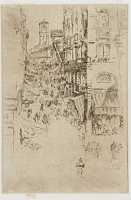Etchings Institutions search term: grolier club
The Rialto | ||
| Number: | 199 | |
| Date: | 1879/1880 | |
| Medium: | etching and drypoint | |
| Size: | 298 x 203 mm | |
| Signed: | butterfly at left (3) | |
| Inscribed: | no | |
| Set/Publication: | 'Second Venice Set', 1886 | |
| No. of States: | 3 | |
| Known impressions: | 36 | |
| Catalogues: | K.211; M.208; W.181 | |
| Impressions taken from this plate (36) | ||
PUBLICATION
Whistler delivered in all 1093 prints and was paid £2.10.6 for printing each dozen prints. 8
8: Dowdeswell to Whistler, invoice 16 July 1887, GUW #00891.
EXHIBITIONS
"Scampering caprice". - S. Colvin.
"Mr. Whistler's drawing, which is sometimes that of a very slovenly master."' 9
9: London FAS 1883 (cat. no. 41).
'REFLECTION: This Critic, it is true, is a Slade Professor.' accompanied by a manic butterfly with a sting in its tail.
At the time of the F.A.S. 1883 show, The Rialto received a range of critical comments. The Queen thought The Rialto 'good both in tone and line', catching 'life and movement in the scene generally.' 11 The Globe critic was more ambivalent :
10: 'Mr. Whistler's "Venice" at the Fine-Art Society, New Bond Street', Spectator, vol. 53, no. 2737, 11 December 1880, pp.1586-7 (GUL PC4, pp.13, 82).
11: Anon., 'An Arrangement in White and Yellow', The Queen, 24 February 1883 (GUL PC 25/24).
12: Anon., 'Mr Whistler's Etchings', Globe, 19 February 1883 (GUL PC 25/19).
13: St James Gazette, 20 February 1883 (GUL PC 25/30).
Impressions were shown in International Exhibitions, including Glasgow in 1888, lent by Bernard Buchanan MacGeorge (1845?-1924) (possibly
 ), and 1901, lent by James Cox-Cox (ca 1849- d.1901). 15 An impression was lent by Charles Lang Freer (1856-1919) to an exhibition held at the Caxton Club in Chicago in 1900 (
), and 1901, lent by James Cox-Cox (ca 1849- d.1901). 15 An impression was lent by Charles Lang Freer (1856-1919) to an exhibition held at the Caxton Club in Chicago in 1900 ( or
or  ). 16 Others were shown at the Pan-American Exposition in Buffalo in 1901, and, lent by Howard Mansfield (1849-1938), in Philadelphia in 1902. 17 One was shown in an Art and Industrial Exhibition in Wolverhampton in 1902; C. Lewis Hind commented: 'how good it is suddenly to come upon thirty etchings by Mr. Whistler, some of the Thames and Venice pieces, and other little masterpieces, so small yet so sufficient'. 18
). 16 Others were shown at the Pan-American Exposition in Buffalo in 1901, and, lent by Howard Mansfield (1849-1938), in Philadelphia in 1902. 17 One was shown in an Art and Industrial Exhibition in Wolverhampton in 1902; C. Lewis Hind commented: 'how good it is suddenly to come upon thirty etchings by Mr. Whistler, some of the Thames and Venice pieces, and other little masterpieces, so small yet so sufficient'. 18
Then, after Whistler's death, two impressions were shown at the Grolier Club in New York in 1904. Mansfield lent his impression to the Whistler Memorial exhibition held in Boston in 1904, the Royal Collection lent to the London Memorial in 1905 (
 ), and another impression was shown at the Memorial show in Paris in that year. 19
), and another impression was shown at the Memorial show in Paris in that year. 19
14: See REFERENCES: EXHIBITIONS.
15: Glasgow 1888 (cat. no. 2552-22); Glasgow 1901 (cat. no. 241).
16: Chicago 1900 (cat. no. 161).
17: Philadelphia 1902 (cat. no. 947 [181]).
18: C. L[ewis] H[ind], 'Art at Wolverhampton', The Academy and Literature, 19 July 1902.
19: New York 1904a (cat. nos. 183 a, b); Boston 1904 (cat. no. 142); London Mem. 1905 (cat. no. 181).
SALES & COLLECTORS
 ). It was 1902 before the next sale recorded, when he sold one to Robert Dunthorne (b. ca 1851) on 24 December for £12.12.0. 20
). It was 1902 before the next sale recorded, when he sold one to Robert Dunthorne (b. ca 1851) on 24 December for £12.12.0. 20
 ). Thibaudeau sold a set through Gustave Lauser (b. ca 1841) to H. Wunderlich & Co., New York, who sold it to Margaret Selkirk Watson Parker (1867-1936) (
). Thibaudeau sold a set through Gustave Lauser (b. ca 1841) to H. Wunderlich & Co., New York, who sold it to Margaret Selkirk Watson Parker (1867-1936) ( ). Other dealers also distributed the etchings. Charles Lang Freer (1856-1919) bought the second state from F. Keppel & Co. in 1887 (
). Other dealers also distributed the etchings. Charles Lang Freer (1856-1919) bought the second state from F. Keppel & Co. in 1887 ( ) and the first state from Obach & Co. in 1905 (
) and the first state from Obach & Co. in 1905 ( ).
). ); Alfred Beurdeley (1847-1919) (
); Alfred Beurdeley (1847-1919) ( ); George Aloysius Lucas (1824-1909) (
); George Aloysius Lucas (1824-1909) ( ) and Bernard Buchanan MacGeorge (1845?-1924) (
) and Bernard Buchanan MacGeorge (1845?-1924) ( ).
).
